A container ship (also known as a boxship or containership) is a cargo ship that transports all of its cargo in truck-size intermodal containers, a process known as containerization. Container ships are a common mode of commercial intermodal freight transport, and they now transport the majority of seagoing non-bulk cargo.
Containerization is an intermodal freight transport system that employs intermodal containers (also known as shipping containers or ISO containers). Containerization, also known as container stuffing or container loading, is the process of unitizing export cargoes. Containerization, as opposed to other systems such as the barge system or palletization, is the most common method of unitizing export cargoes. The dimensions of the containers are consistent. They can be loaded and unloaded, stacked, efficiently transported over long distances, and transferred without being opened from one mode of transport to another—container ships, rail transport flatcars, and semi-trailer trucks. The handling system is mechanized, with cranes and special forklift trucks handling everything. Computerized systems are used to number and track all containers.
Dry cargo is classified into two types: bulk cargo and break bulk cargo. Bulk cargoes, such as grain or coal, are transported unpackaged in the ship’s hull in large quantities. Break-bulk cargoes, on the other hand, are generally manufactured goods and are transported in packages. Prior to the introduction of containerization in the 1950s, break-bulk items were loaded, lashed, unlashed, and unloaded from ships one at a time. By grouping cargo into containers, however, 1,000 to 3,000 cubic feet (28 to 85 m3) of cargo, or up to approximately 64,000 pounds (29,000 kg), can be moved at once, and each container is secured to the ship once in a standardized manner.
The first ships designed to carry standardized load units were used in England in the late 18th century. The box boat “Starvationer” with ten wooden containers was designed by James Brindley in 1766 to transport coal from Worsley Delph to Manchester via the Bridgewater Canal. Prior to WWII, container ships were used to transport the luggage of the luxury passenger train from London to Paris (Southern Railway’s Golden Arrow / La Flèche d’Or). These containers were loaded in London or Paris and transported on flat cars to the ports of Dover or Calais. The Autocarrier, owned by Southern Railway UK, was launched in February 1931 as the world’s first container ship. It had 21 slots for Southern Railway containers.
The first container ships built after WWII were converted oil tankers built from surplus T2 tankers. The first purpose-built container ships began service in Denmark and between Seattle and Alaska in 1951. Ideal X, a T2 tanker owned by Malcom McLean, carried 58 metal containers between Newark, New Jersey and Houston, Texas on its first voyage.McLean Trucking, which he founded in 1955, grew into one of the largest freighter fleets in the United States. In 1955, he bought the small Pan Atlantic Steamship Company from Waterman Steamship and converted its ships to carry cargo in large uniform metal containers. The first of these rebuilt container ships, Ideal X, was launched on April 26, 1956.
Container ships do away with the individual hatches, holds, and dividers found on traditional general cargo ships. A typical container ship’s hull is a massive warehouse divided into cells by vertical guide rails. These cells are built to hold cargo in pre-packaged units known as containers. Steel is the most common material used in shipping containers, but aluminium, fibreglass, and plywood are also used. They are designed to be completely transferred to and from smaller coastal carriers, trains, trucks, or semi-trailers (and thus are carried by different modes of transport during the same voyage, giving rise to the term intermodal transport). There are various types of containers, which are classified based on their size and function.
Modern container ships are designed with several key points in mind. The hull is built around a strong keel, similar to that of bulk carriers and general cargo ships. One or more below-deck cargo holds, numerous tanks, and the engine room are built into this frame. The hatch covers on top of the holds allow more containers to be stacked. Cargo cranes are installed on many container ships, and some have specialized systems for securing containers on board.
Various systems are used to secure containers aboard ships, depending on factors such as ship type, container type, and container location. The simplest method of stowing containers inside the holds of fully cellular (FC) ships is to use simple metal forms called container guides, locating cones, and anti-rack spacers to lock the containers together. More complicated equipment is used above-decks, without the extra support of the cell guides. There are three types of systems in use today: lashing systems, locking systems, and buttress systems. Lashing systems use wire rope, rigid rods, or chains to secure containers to the ship, as well as turnbuckles to tension the lashings. The buttress system, which is used on some large container ships, consists of a network of large towers attached to the ship at both ends of each cargo hold. A rigid, removable stacking frame is added to the ship as it is loaded, structurally securing each tier of containers together.

Today, container ships transport approximately 90% of non-bulk cargo worldwide, and modern container ships can carry over 24,000 TEU. The largest container ships today are 400 meters (1,300 feet) long. They can carry enough cargo to fill sixteen to seventeen pre-World War II freighter ships.
Each year, up to 1,382 shipping containers are lost at sea, according to a World Shipping Council (WSC) report. The figure is calculated using three-year averages over a 12-year period and represents 80% of global vessel container capacity. This was in effect until 2019.
Now, other estimates paint a more bleak picture :: 2,675 sea containers were lost at sea between November 2020 and January 2021 alone. Furthermore, 2021 saw the highest increase in lost shipping containers since 2013.




